Horizontal and Uplift Bearing Characteristics of a Cast-In-Place Micropile Group Foundation in a Plateau Mountainous Area
Abstract
:1. Introduction
2. Field Testing of Micropile Group Foundations
2.1. Experimental Overview
2.2. Experimental Loading Process and Result Analysis
3. Numerical Simulation Study of the Micropile Foundation
3.1. Establishment of Numerical Model
3.2. Comparison and Analysis of Experimental and Inversion Results
4. Study on Horizontal Uplift Combined Loads
4.1. Pile Strain Response
4.2. Distribution of Average Lateral Frictional Resistance
4.3. Bearing Characteristics under Uplift–Horizontal Load Interaction
5. Conclusions
- (1)
- During the field uplift loading test of micropile group foundations in the plateau mountainous area, the load distribution among individual piles is relatively uniform. The load is transmitted from top to bottom until it reaches the ultimate limit state. The lateral friction resistance of the pile body in the micro pile group foundation follows the order: Part 3 > Part 1 > Part 2.
- (2)
- The micropile group foundation has an ultimate uplift bearing capacity of 1200 kN with a steep load–uplift displacement curve. Its horizontal bearing capacity is 620 kN with a gradual load–horizontal displacement curve. The numerical inversion results are in good agreement with the experimental data, confirming the feasibility of numerically studying the bearing behavior of micro pile group foundations.
- (3)
- Under the combined load–coupling effect, the additional moment M1 generated by the unbalanced lateral friction resistance on both sides of the pile cross-section is greater than the additional moment M2 generated by the P–Δ effect. As a result, the relative displacements and lateral friction resistance on the left and right sides of the upper part of the foundation are different from those under individual uplift loading conditions, and the piles located farther from the soil under compression exhibit larger net bending moments.
- (4)
- Compared to the condition of applying uplift load alone, the flexural deformation of the pile caused by the application of combined loads results in an increase in lateral friction resistance on the Part 2 side, while the lateral friction resistance on both the Part 1 and Part 3 sides decrease. As a result, the overall lateral friction resistance of the pile decreases, leading to a reduction in the ultimate uplift bearing capacity of the foundation. Moreover, the larger the horizontal load, the more significant the reduction effect.
- (5)
- The bearing performance of the micropile group foundation under U–H combined loading is related to the load ratio parameter, n. As n decreases, the uplift bearing capacity of the micropile group foundation continues to weaken, while the horizontal ultimate bearing capacity gradually increases. When n = 0.76, the horizontal bearing capacity of the foundation becomes equivalent to the horizontal bearing capacity under the action of a single horizontal load.
- (6)
- Based on regression analysis of experimental data, the horizontal bearing capacity follows a fourth-order function relationship with the reciprocal of the load ratio, while the uplift bearing capacity exhibits a second-order function relationship with the reciprocal of the load ratio. These bearing characteristics differ from those observed under single-direction loading. The enclosed area between the yield envelope and the plumb line of unidirectional ultimate bearing capacity under the combined load is divided into the “failure zone” and “safety zone.” The reduction in uplift capacity within the “failure zone” should be considered during the pile foundation design.
Author Contributions
Funding
Institutional Review Board Statement
Informed Consent Statement
Data Availability Statement
Acknowledgments
Conflicts of Interest
References
- Liu, S.; Luo, F.; Zhang, G. Centrifuge model tests on pile-reinforced slopes subjected to drawdown. J. Rock Mech. Geotech. Eng. 2020, 12, 1290–1300. [Google Scholar] [CrossRef]
- Sun, Z.; Kong, L.; Wang, Y.; Zhou, Z. Study on seismic response characteristics of a micropile-reinforced filled slope behind a cantilever retaining wall. Chin. J. Rock Mech. Eng. 2022, 41, 2109–2123. [Google Scholar] [CrossRef]
- Kim, D.; Kim, G.; Kim, I.; Lee, J. Assessment of load sharing behavior for micropiled rafts installed with inclined condition. Eng. Struct. 2018, 172, 780–788. [Google Scholar] [CrossRef]
- Liu, L. The Study and The Numerical Analysis of the Bearing Capacity of the Small Precast Pile of Transmission Tower in Soft soil. Master’s Thesis, South China University of Technology, Guangdong, China, 2019. [Google Scholar]
- Xu, Y. Application of Post-Grouting Micro-Steel Pipe Pile in Transmission Line Engineering. Master’s Thesis, North China Electric Power University, Hebei, China, 2016. [Google Scholar]
- White, D.J.; Thompson, M.J.; Suleiman, M.T.; Schaefer, V.R. Behavior of slender piles subject to free-field lateral soil movement. J. Geotech. Geoenviron. Eng. 2008, 134, 428–436. [Google Scholar] [CrossRef]
- Sun, S.W.; Zhu, B.; Wang, J. Design method for stabilization of earth slopes with micropiles. Soils Found. 2013, 53, 487–497. [Google Scholar] [CrossRef]
- Boeckmann, Z.A. Load Transfer in Micropiles for Slope Stabilization from Test of Large-Scale Physical Models. Master’s Thesis, University of Missouri-Columbia, Columbia, MO, USA, 2006. [Google Scholar] [CrossRef]
- Sun, S. Researching on the Disturbed Zone for Cutting Bedding High Rock Slope and Calculation Method of Micro-Pile. Master’s Thesis, China Academy of Railway Sciences, Beijing, China, 2006. [Google Scholar]
- Chen, Z.; Mei, L.; Mei, G. Numerical simulation of lateral bearing capacity of flexible micropile. Rock Soil Mech. 2011, 32, 2219–2224. [Google Scholar] [CrossRef]
- Liu, N.; Huang, Y.; Wu, B.; Huang, W. Experimental Study on Lateral Bearing Mechanical Characteristics and Damage Numerical Simulation of Micropile. Adv. Civ. Eng. 2021, 2021, 9927922. [Google Scholar] [CrossRef]
- Ghorbani, A.; Hasanzadehshooiili, H.; Ghamari, E.; Medzvieckas, J. Comprehensive three dimensional finite element analysis, parametric study and sensitivity analysis on the seismic performance of soil–micropile-superstructure interaction. Soil Dyn. Earthq. Eng. 2014, 58, 21–36. [Google Scholar] [CrossRef]
- Malik, B.A.; Sha, M.Y.; Sawant, V.A. Influence of micropile parameters on bearing capacity of footings. J. Environ. Sci. Pollut. Res. 2021, 28, 48274–48283. [Google Scholar] [CrossRef]
- Moradi, M.M.; Keramati, M.; Ramesh, A.; Naderi, R. Experimental evaluation of the effects of structural parameters, installation methods and soil density on the micropile bearing capacity. Int. J. Civ. Eng. 2021, 19, 1313–1325. [Google Scholar] [CrossRef]
- Luo, H.; Zhang, R.; Nie, R. Experimental study on compressive bearing characteristics of micro-steel-pile piles in red-bed soft rock. China J. Highw. Transp 2022, 35, 97–106. [Google Scholar] [CrossRef]
- Xia, J.; Bai, H.J.; Wang, J.J. Uplift and press bearing capacity of micro-pile foundation for transmission line on loess ground. Chin. J. Appl. Mech. 2023, 40, 340–349. [Google Scholar]
- Zhang, R.; Luo, H.; Liu, Z.; Nie, R. Study on Anti-Uplift Effect of Micro-Steel-Pipe Pile on Red-Bedded Soft Rock Subgrade. Sustainability 2022, 14, 11923. [Google Scholar] [CrossRef]
- Murthy, B.; Babu, G.; Srinivas, A. Analysis of bearing capacity improvement using micropiles. Ground Improv. 2002, 6, 121–128. [Google Scholar] [CrossRef]
- Liu, X.; Liu, Y.; Liu, K.; Su, Y. Experimental investigation on anti-sliding performance of grouted micro-pipe pile groups. Nat. Hazards 2022, 113, 1367–1384. [Google Scholar] [CrossRef]
- Zhang, A.; Fu, H.; Wang, J.; Wang, X.P.; Tian, S.; Sun, Q. Study on uplift bearing capacity and group pile effect of micro-pile group in loess foundation. Build. Struct. 2022, 52, 120–125. [Google Scholar] [CrossRef]
- Kershaw, K.A.; Luna, R. Scale model investigation of the effect of vertical load on the lateral response of micropiles in sand. DFI J. J. Deep Found. Inst. 2018, 12, 3–15. [Google Scholar] [CrossRef]
- Hazzar, L.; Hussien, M.N.; Karray, M. On the behaviour of pile groups under combined lateral and vertical loading. Ocean Eng. 2017, 131, 174–185. [Google Scholar] [CrossRef]
- Sharma, B.; Buragohain, P. Behaviour of micropile groups under oblique pull out loads in sand. Indian Geotech. J. 2014, 44, 400–408. [Google Scholar] [CrossRef]
- Zheng, W.; Su, R.; Lu, X.; Cheng, X. Field test on micropiles in foundation of transmission line tower. J. Liaoning Tech. Univ. 2010, 29, 79–82. [Google Scholar]
- Zheng, J.; Niu, W.; Wu, H.; Shi, Y. Research on the characteristics of large-scale shaking table experiment slope and dynamy of micropiles. J. Railw. Eng. Soc. 2017, 34, 22–28. [Google Scholar]
- Wang, M.; Zhao, K.; Zhu, Q.; Xu, X. Seismic responses of a micropile in liquefiable soils. Rock Soil Mech. 2016, 37, 1543–1549. [Google Scholar] [CrossRef]
- Pei, Z.; Zhang, Y.; Nian, T.; Song, X.; Zhao, W. Performance investigation of micropile groups in stabilizing unstable talus slopes via centrifuge model tests. Can. Geotech. J. 2022, 60, 351–365. [Google Scholar] [CrossRef]
- Pei, Z.; Zhang, Y.; Nian, T.; Xiao, S.; Liu, H. Cross-Scale Analysis on the Working Performance of Micropile Group and Talus Slope System. Sustainability 2023, 15, 8154. [Google Scholar] [CrossRef]
- Borthakur, N.; Dey, A.K. Experimental investigation on load carrying capacity of micropiles in soft clay. Arab. J. Sci. Eng. 2018, 43, 1969–1981. [Google Scholar] [CrossRef]
- Zeng, Y.; Wang, N.; Zhang, W.; Xu, G. Study on centrifuge model tests of mini-pile foundation in soft soil. Chin. J. Geotech. Eng. 2003, 25, 242–245. [Google Scholar]
- Du, Y.; Bai, M.; Qiu, S.; Shen, Y. Experimental study on lateral bearing capacity of concentrated micropiles. Chin. J. Rock Mech. Eng. 2015, 34, 821–830. [Google Scholar] [CrossRef]
- Zhang, Y. Mechanical Analysis of Micro-Pile Anti-Slide Composite Structur−An Improved Method Based on The Theory of Low-Cap Pile Foundation. Master’s Thesis, Southwest Jiaotong University, Chengdu, China, 2011. [Google Scholar]
- Xu, X.; Zhang, T.; Wang, J.; Hu, M.; Chen, K. Model tests on the bearing capacity of precast open-ended micro pipe piles in soft soil. Geotech. Eng. 2020, 173, 500–518. [Google Scholar] [CrossRef]
- Hussain, Z.; Sharma, B.; Rahman, T. Micropile group behaviour subjected to lateral loading. Innov. Infrastruct. Solut 2019, 4, 22. [Google Scholar] [CrossRef]
- Dai, G.; Dai, Y.; Liu, Y.; Gong, W. Study of pile group effect coefficient for super-long bored piles. China Civ. Eng. J. 2011, 44, 107–112. [Google Scholar] [CrossRef]
- Yan, Z.; Xu, Z. Anisotropy of soils and its approximate simulation. Chin. J. Geotech. Eng. 2002, 24, 547–551. [Google Scholar]
- Kang, S.; Noh, J.; Jang, H. Support characteristics of eco-spiral pile with respect to twisting angle and ratio of borehole diameter to pile width. Int. J. Min. Reclam. Environ. 2019, 33, 265–285. [Google Scholar] [CrossRef]
- Zhou, L.D.; Kong, G.Q.; Peng, H.F.; Gu, H.W. Theoretical analysis of bearing capacities of pile group under oblique load. Rock Soil Mech. 2017, 38, 2647–2654. [Google Scholar] [CrossRef]
- Zhang, L.; Hai, W.; Gan, H.; Cao, W.; Wang, T. Study on bearing behavior of flexible single pile subject to horizontal and uplift combined load. Rock Soils Mech. 2020, 41, 2261–2270. [Google Scholar] [CrossRef]
- Meyerhof, G.G.; Ranjian, G. The bearing capacity of rigid piles under inclined loads in sand. ii: Batter piles. Can. Geotech. J. 2011, 9, 430–446. [Google Scholar] [CrossRef]
- Koummoto, T.; Meyerhof, G.G.; Sastry, V.V.R.N. Analysis of bearing capacity of rigid piles under eccentric and inclined loads. J. Can. Geotech. J. 1986, 23, 127–131. [Google Scholar] [CrossRef]
- Li, S.F.; Zhao, C.F.; Xian, F.R.; Xie, X.L. Bearing mechanism of single pile under combined loads. J. Guangxi Univ. Nat. Sci. Ed. 2013, 38, 969–974. [Google Scholar] [CrossRef]

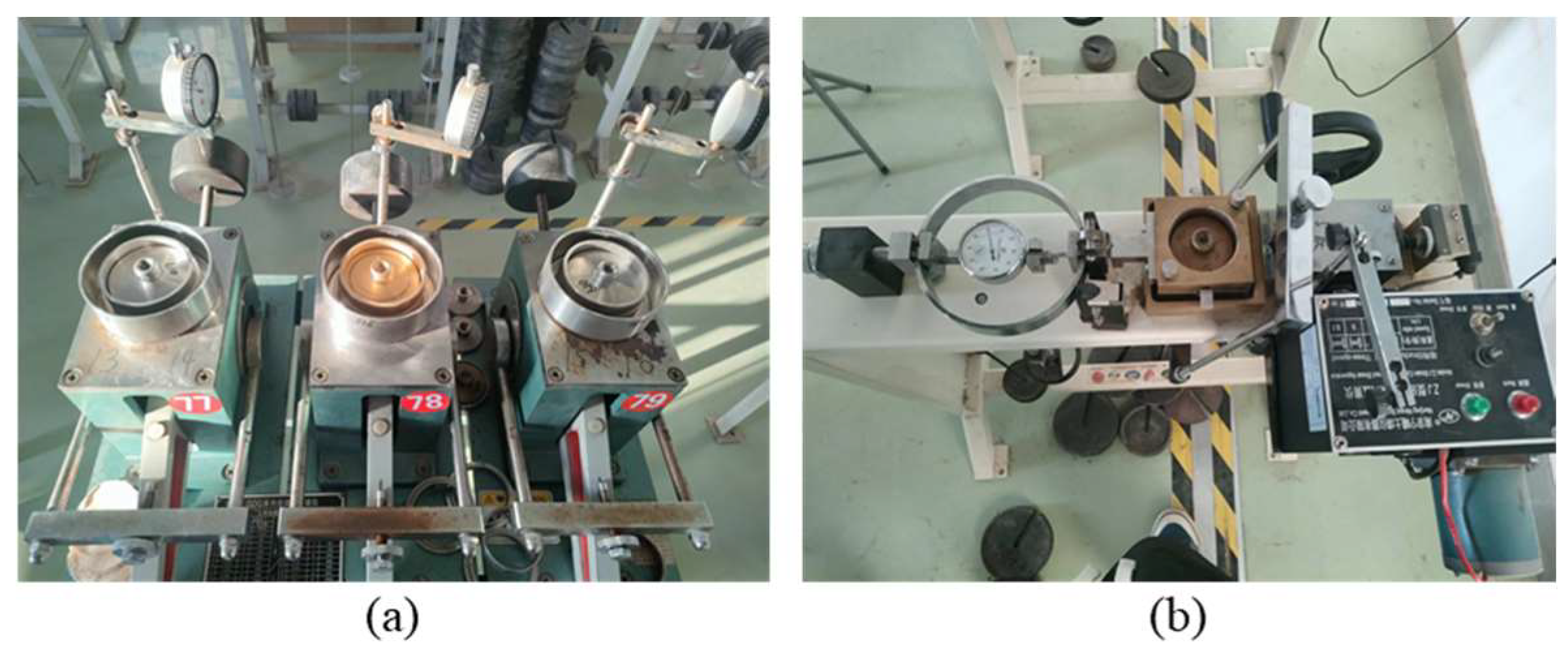
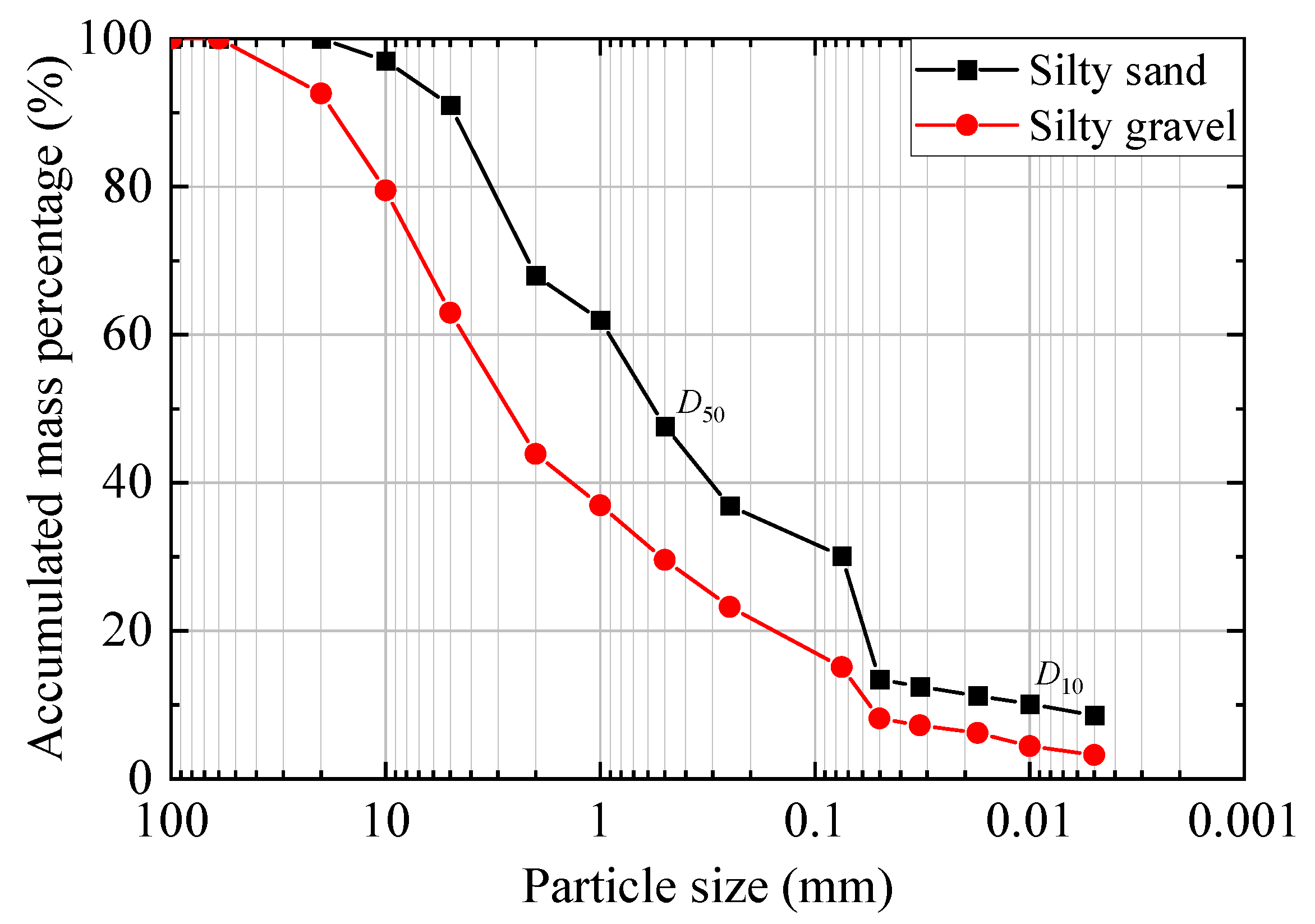
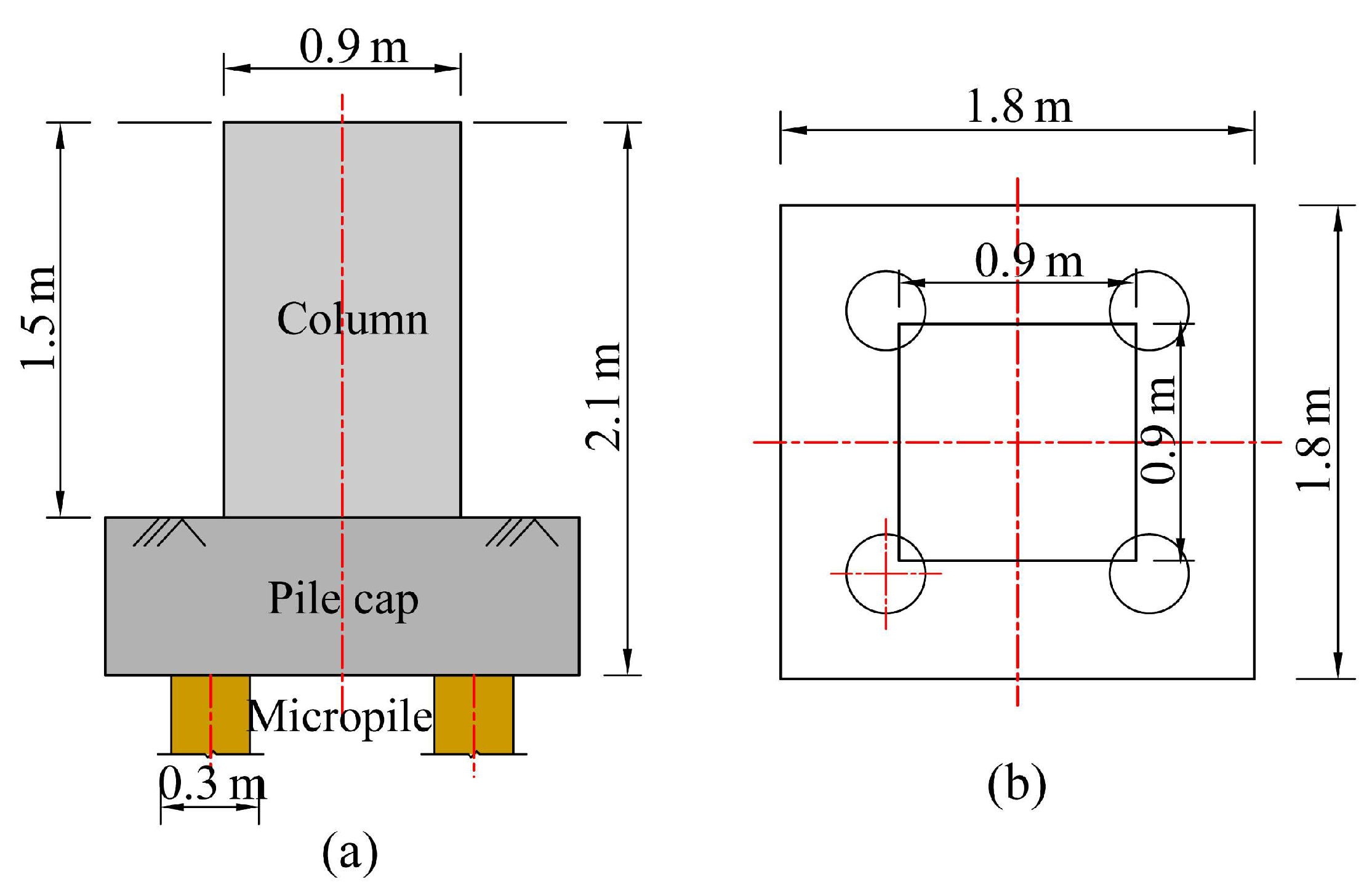

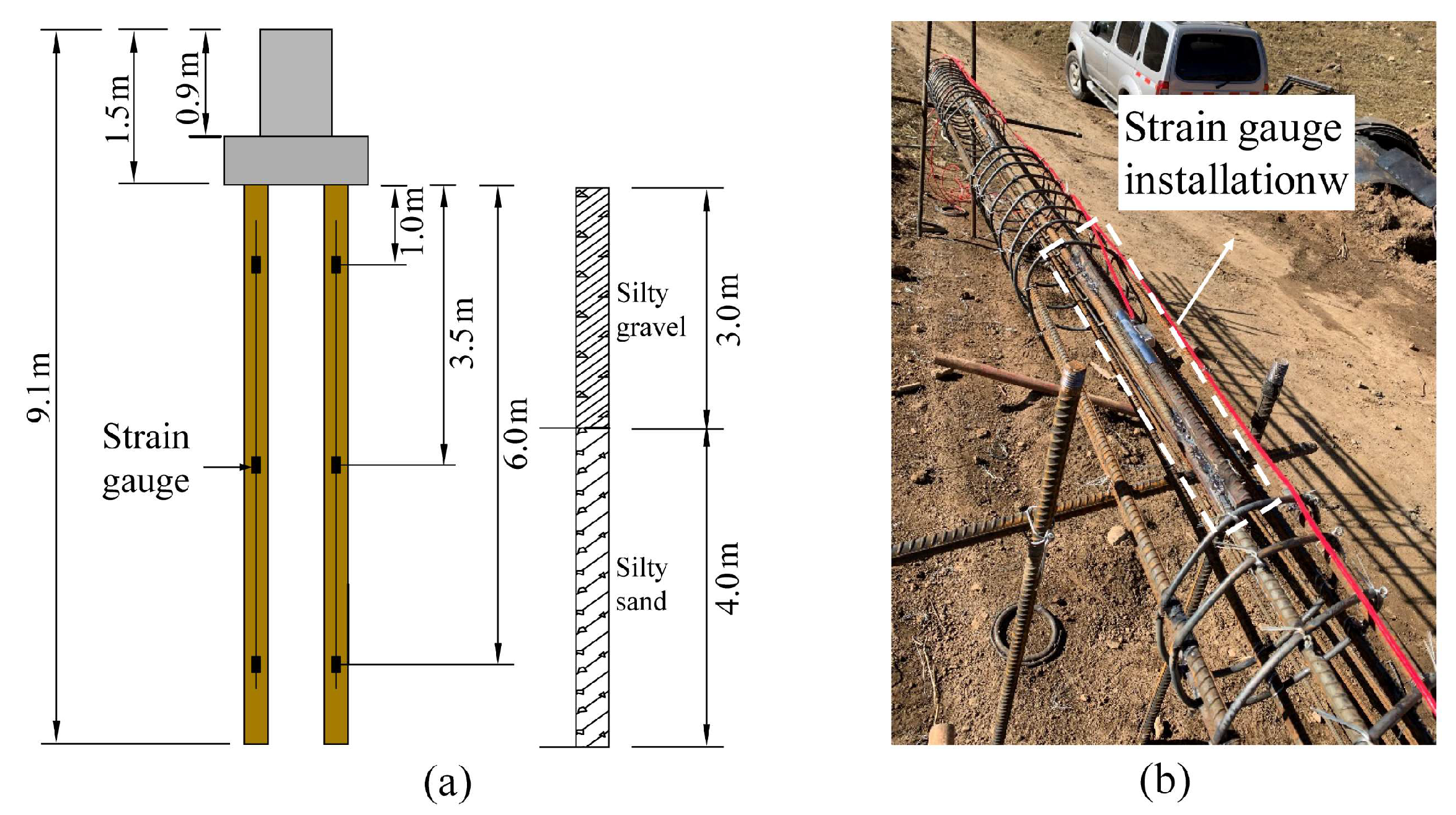
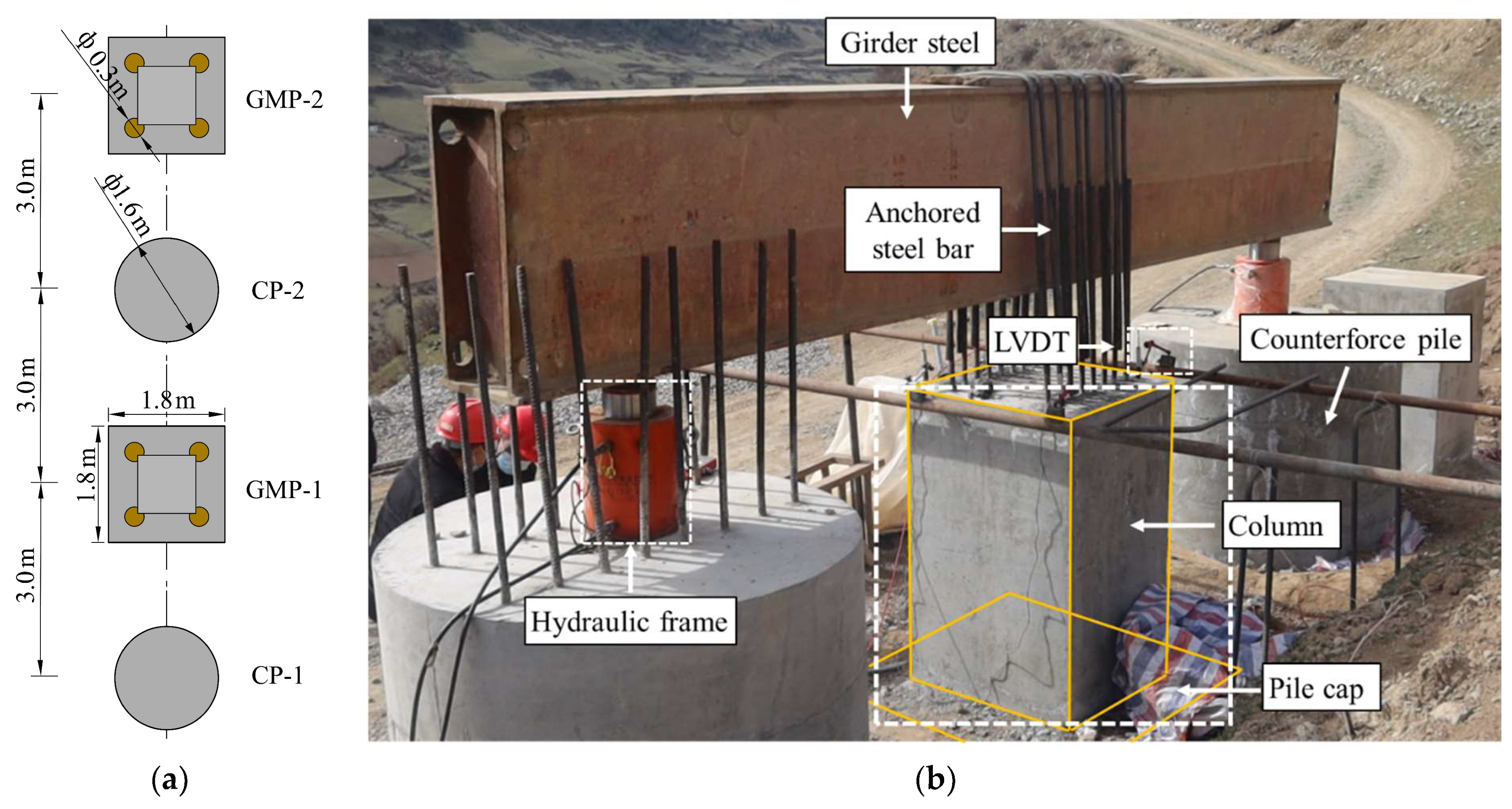
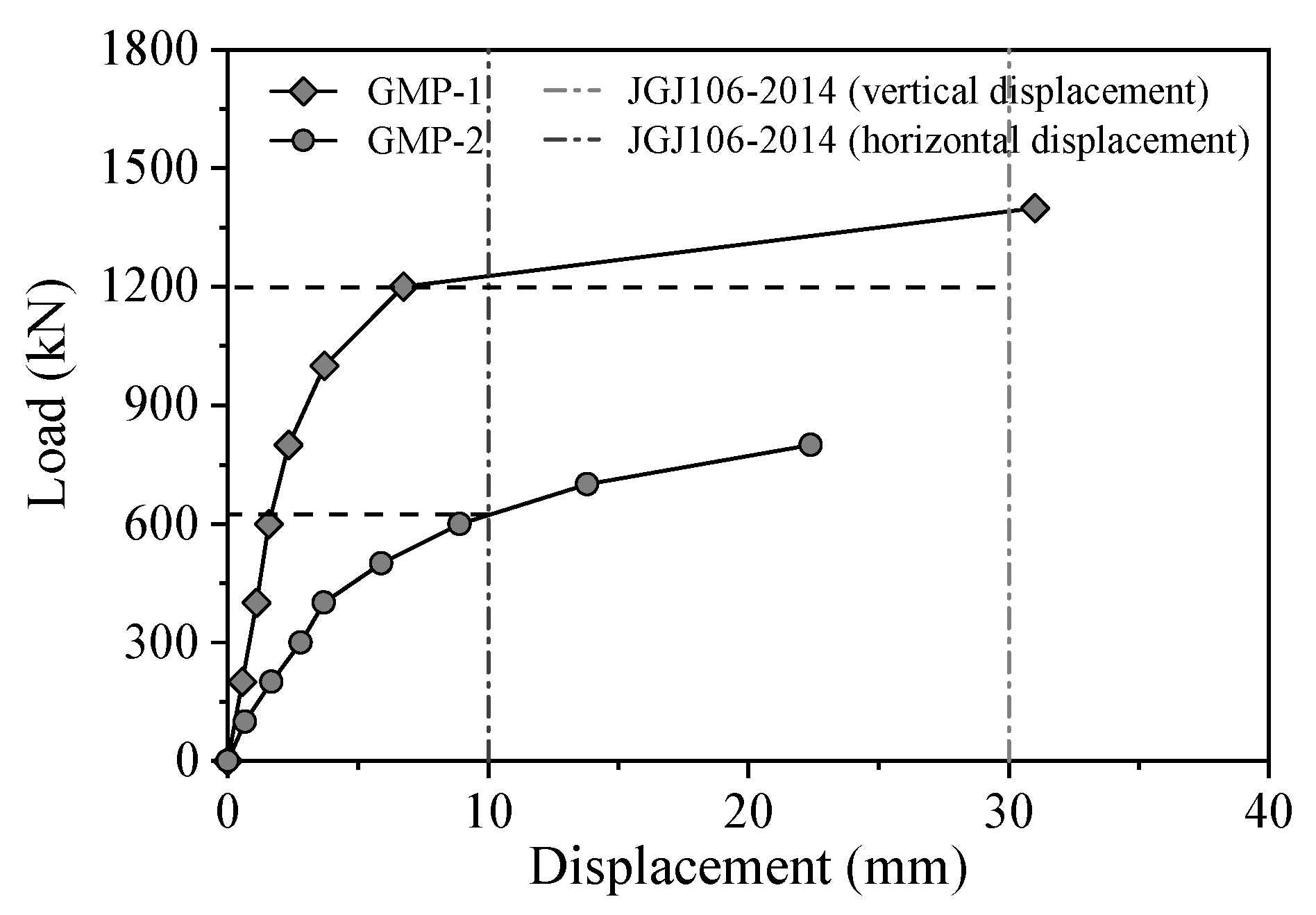
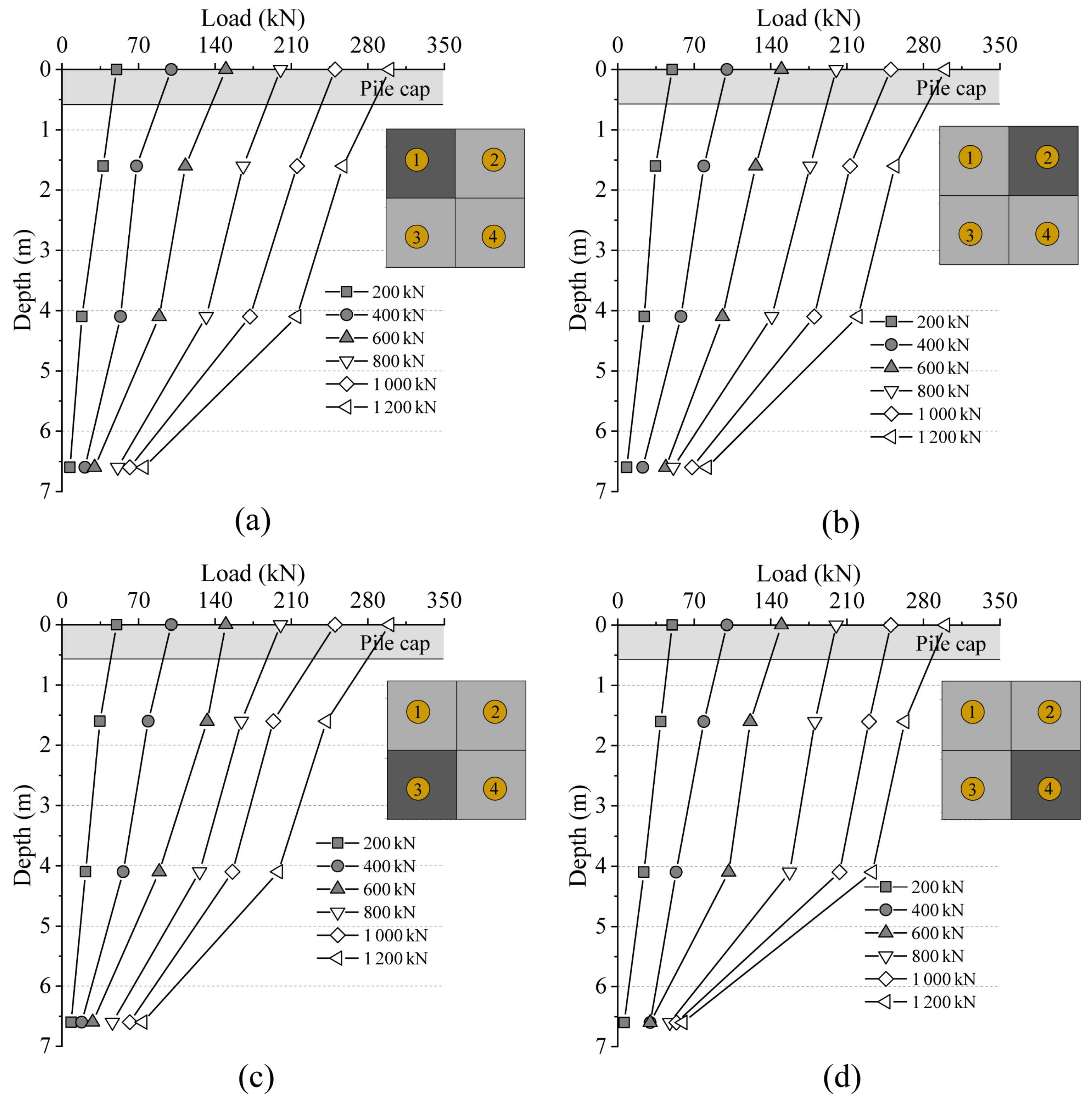


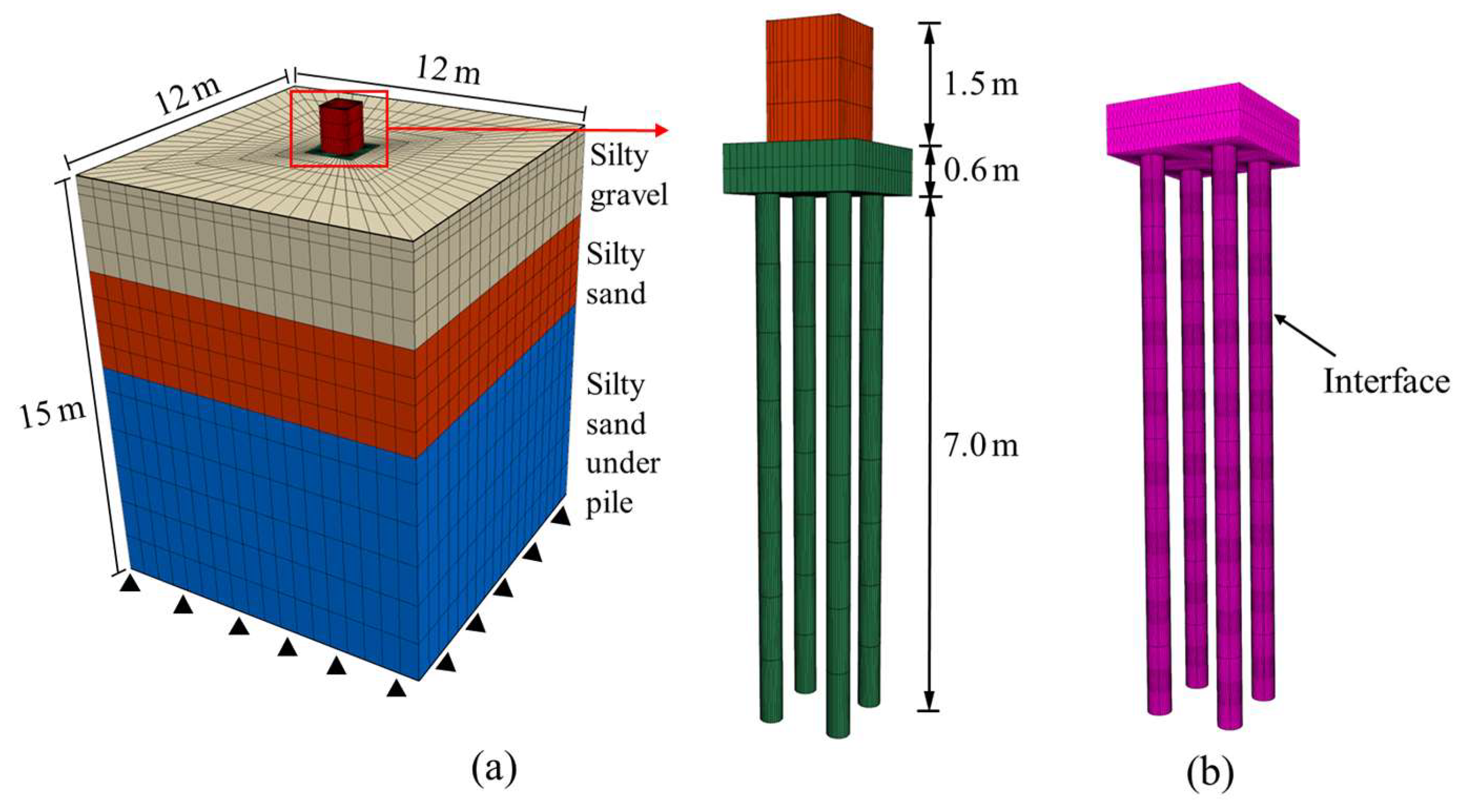
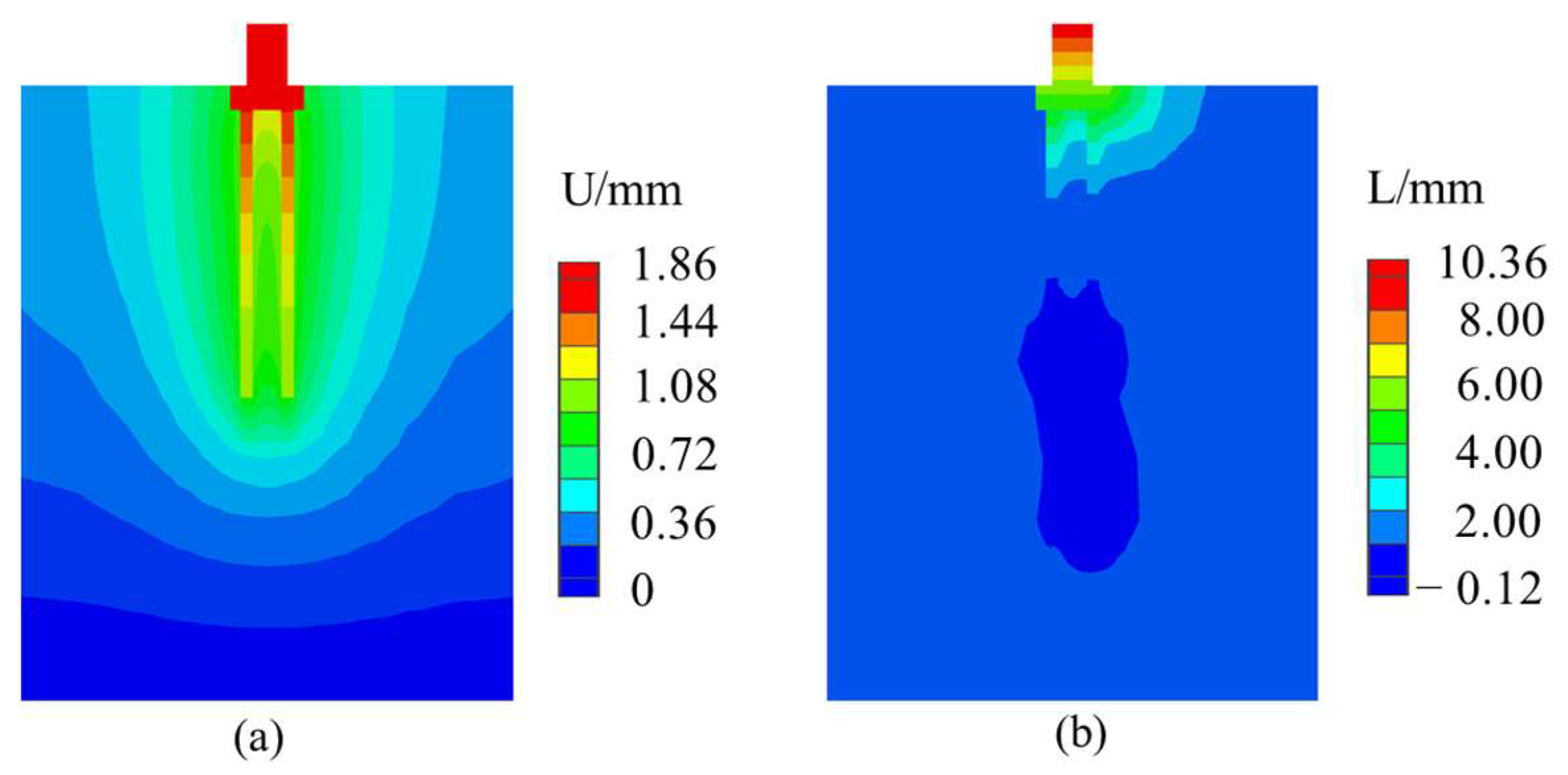
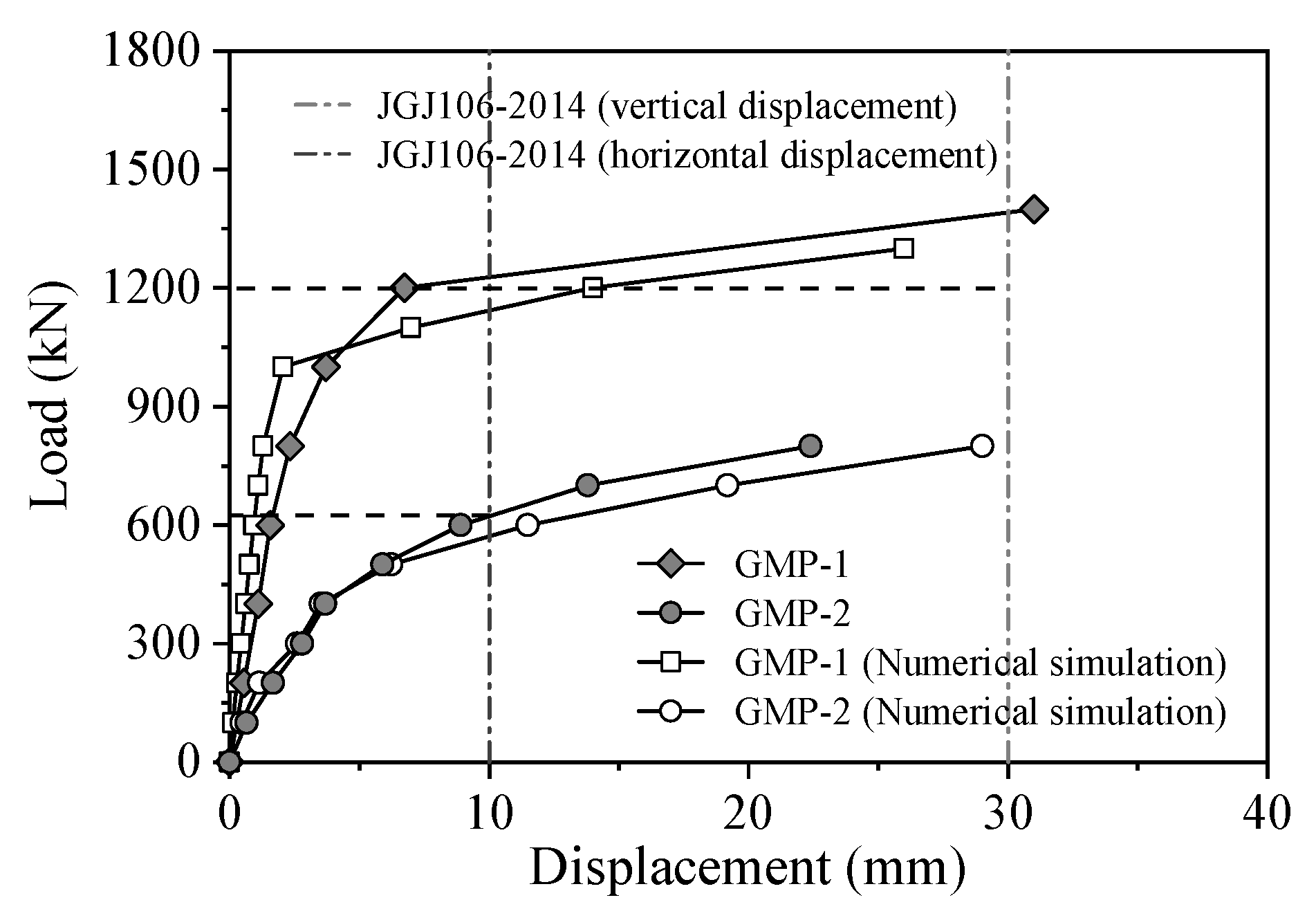
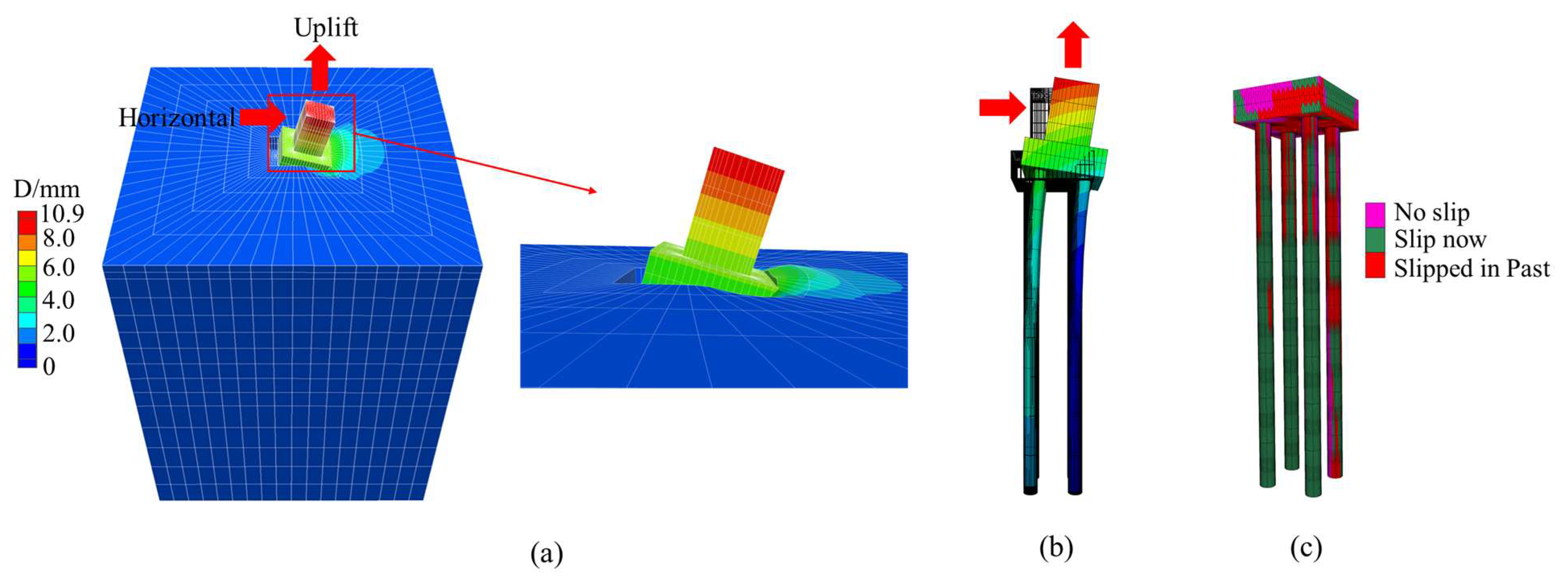
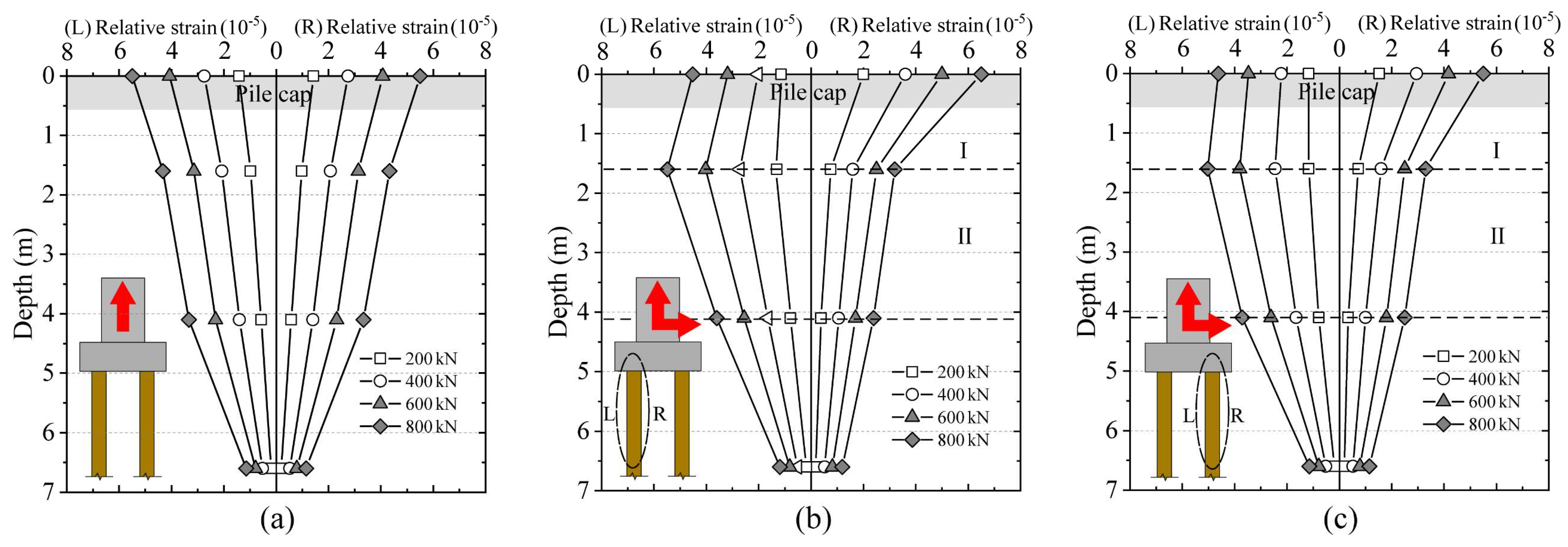
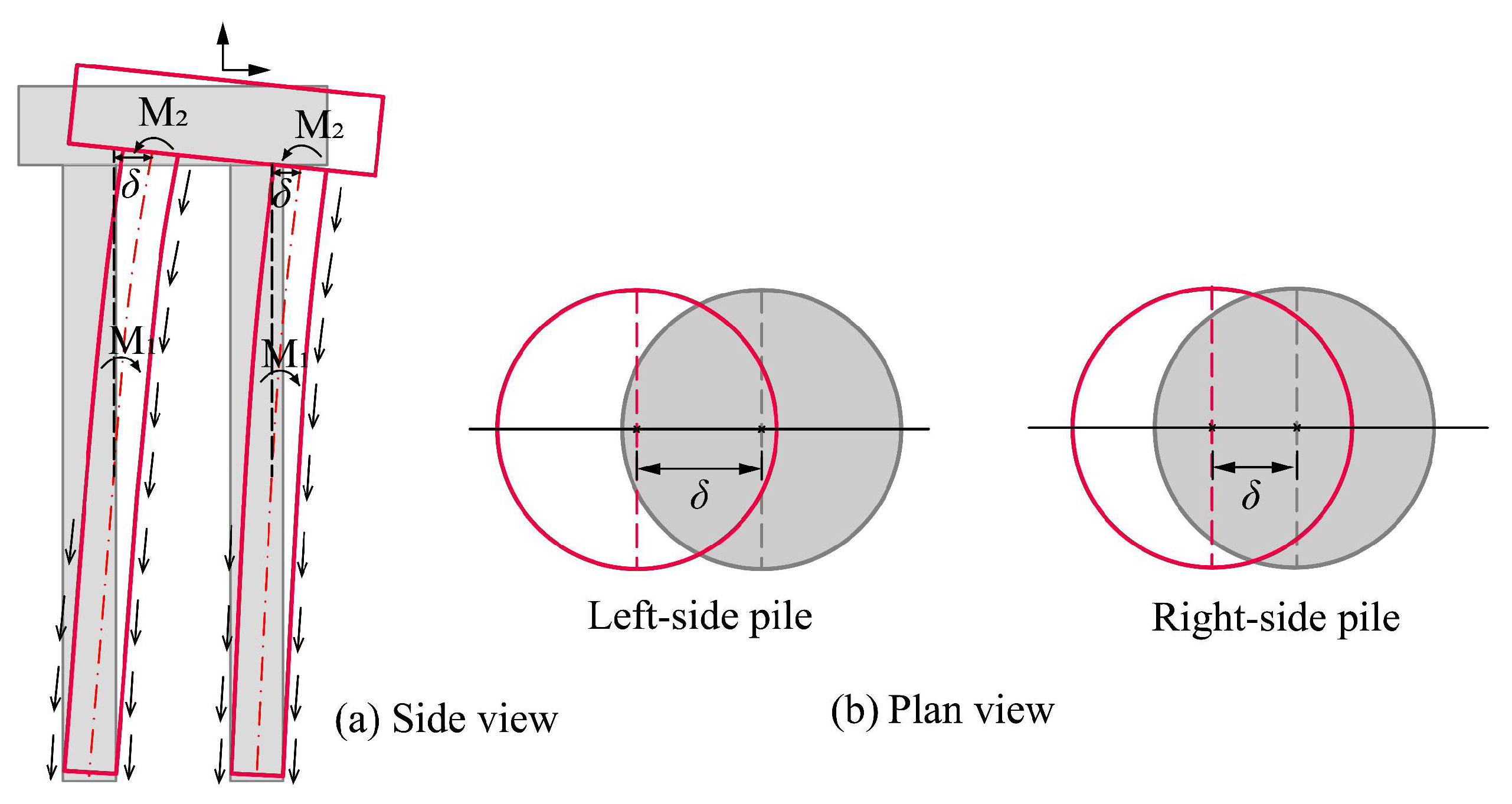
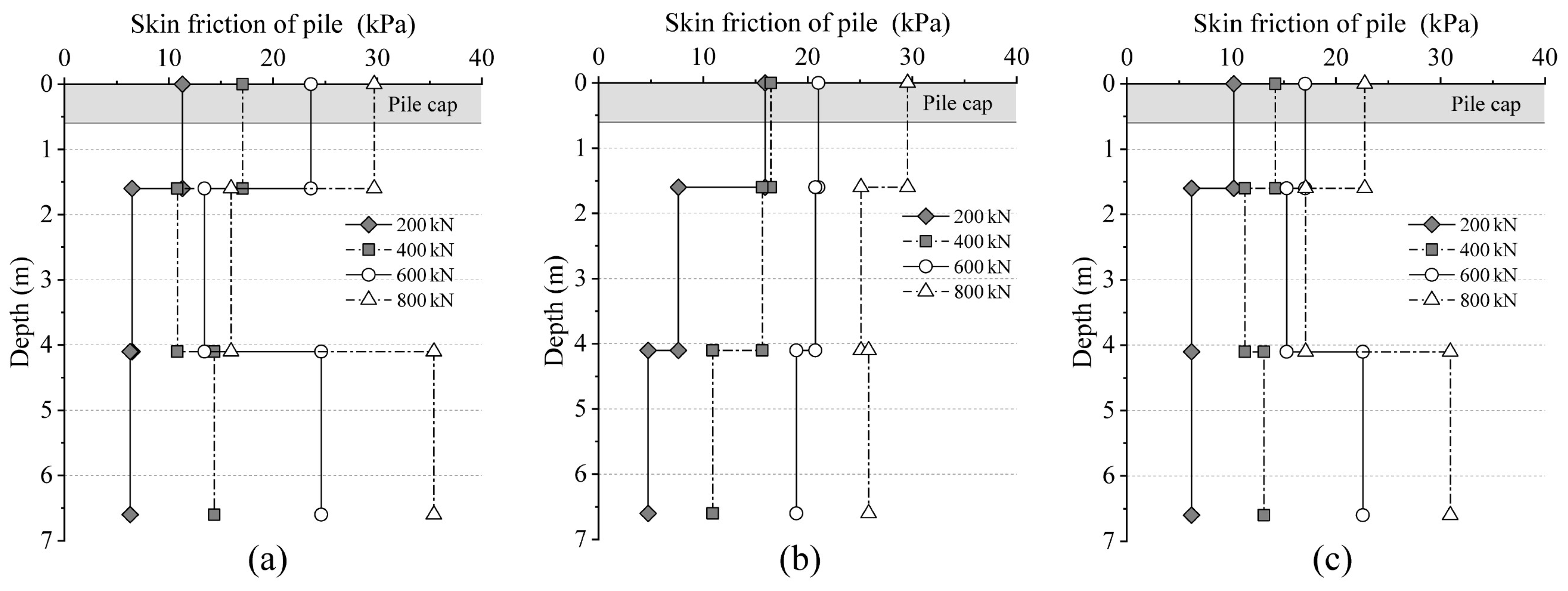
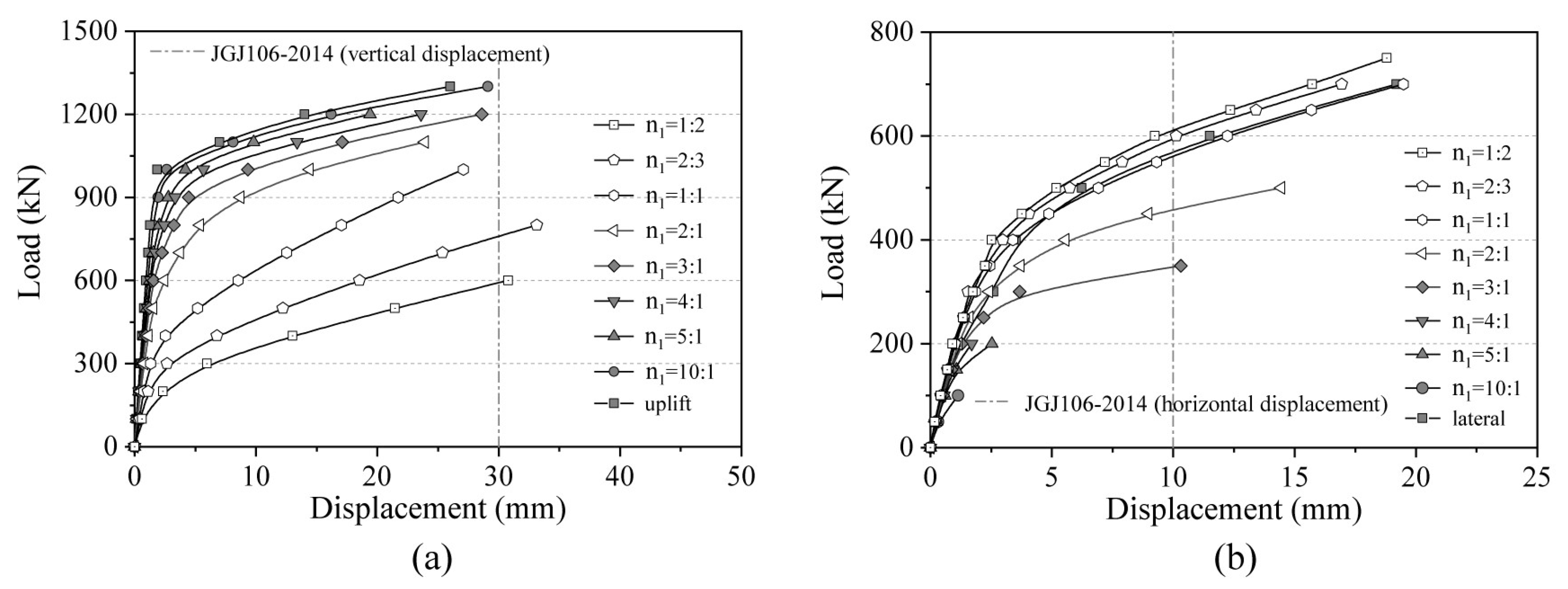
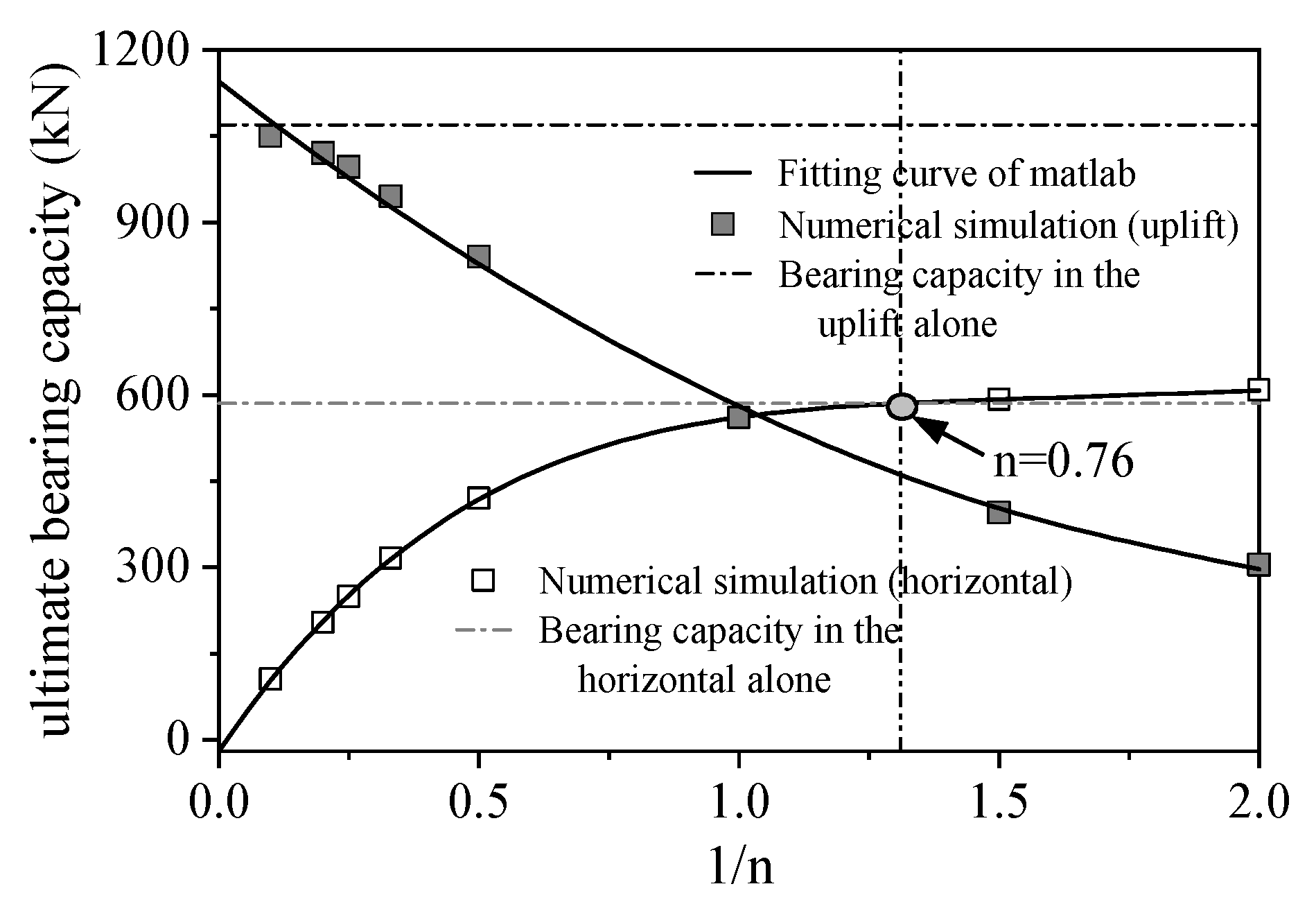
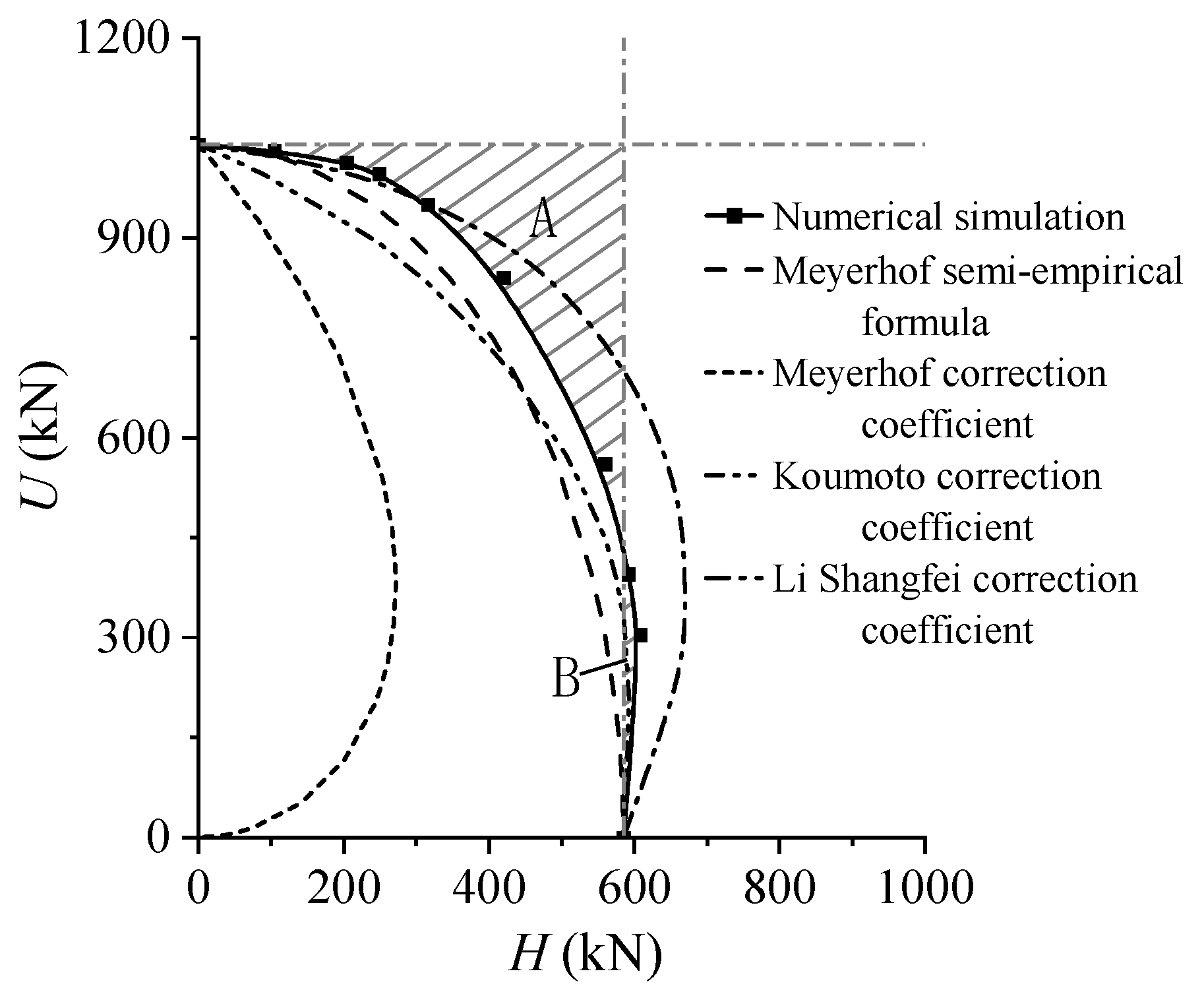
| Sample ID | Sampling Depth/m | Water Content/% | Plasticity Index | Compression Modulus /MPa | Poisson Ratio | Cohesion /kPa | Internal Friction Angle/(°) |
|---|---|---|---|---|---|---|---|
| 1 | 0~1.6 | 22.94 | 12.5 | 14.9 | 0.33 | 12.50 | 25.60 |
| 2 | 1.6~3.0 | 20.12 | 13.0 | 15.3 | 0.32 | 14.89 | 28.45 |
| 3 | 3.0~3.9 | 19.89 | 11.6 | 18.8 | 0.30 | 20.47 | 15.05 |
| 4 | 5.2~5.8 | 22.18 | 14.5 | 19.4 | 0.29 | 23.08 | 17.39 |
| 5 | 5.8~6.2 | 21.86 | 14.8 | 21.5 | 0.30 | 23.61 | 17.87 |
| 6 | 8.0~9.0 | 24.43 | 15.1 | 15.4 | 0.32 | 17.18 | 30.49 |
| Type of Load | Field Test (kN) | Simplified Standard Calculation Method (kN) | Deviation Rate |
|---|---|---|---|
| Uplift Load | 1200 | 1109 | 7.6% |
| Lateral Load | 620 | 596 | 3.9% |
| Name | Depth /m | Density /(g/cm3) | Elastic Modulus /MPa | Poisson Ratio | Cohesion /kPa | Internal Friction Angle/(°) |
|---|---|---|---|---|---|---|
| Silty gravel | 0~3 | 2.09 | 4.9 | 0.32 | 13.70 | 27.03 |
| Silty sand | >3 | 2.13 | 8.2 | 0.30 | 21.39 | 16.77 |
| Pile body | \ | 2.50 | 31,500.0 | 0.20 | \ | \ |
| Pile cap | \ | 2.50 | 31,500.0 | 0.20 | \ | \ |
| Upper columns | \ | 2.50 | 31,500.0 | 0.20 | \ | \ |
| Name | Shear Stiffness | Normal Stiffness | Cohesion/kPa | Internal Friction Angle/(°) |
|---|---|---|---|---|
| Interface 1 | 7 × 109 | 7 × 109 | 10.96 | 21.62 |
| Interface 2 | 7 × 109 | 7 × 109 | 17.11 | 13.42 |
| Ratio of Uplift to Horizontal Load | 10:1 | 5:1 | 4:1 | 3:1 | 2:1 | 1:1 | 2:3 | 1:2 | |
|---|---|---|---|---|---|---|---|---|---|
| failure load /kN | uplift | 1030 * | 1020 * | 996 * | 950 * | 840 | 560 | 395 | 304 |
| horizontal | 105 | 204 | 249 | 316 | 420 * | 560 * | 592 * | 608 * | |
Disclaimer/Publisher’s Note: The statements, opinions and data contained in all publications are solely those of the individual author(s) and contributor(s) and not of MDPI and/or the editor(s). MDPI and/or the editor(s) disclaim responsibility for any injury to people or property resulting from any ideas, methods, instructions or products referred to in the content. |
© 2023 by the authors. Licensee MDPI, Basel, Switzerland. This article is an open access article distributed under the terms and conditions of the Creative Commons Attribution (CC BY) license (https://creativecommons.org/licenses/by/4.0/).
Share and Cite
Li, H.; Ren, G. Horizontal and Uplift Bearing Characteristics of a Cast-In-Place Micropile Group Foundation in a Plateau Mountainous Area. Sustainability 2023, 15, 13554. https://doi.org/10.3390/su151813554
Li H, Ren G. Horizontal and Uplift Bearing Characteristics of a Cast-In-Place Micropile Group Foundation in a Plateau Mountainous Area. Sustainability. 2023; 15(18):13554. https://doi.org/10.3390/su151813554
Chicago/Turabian StyleLi, Haitao, and Guangming Ren. 2023. "Horizontal and Uplift Bearing Characteristics of a Cast-In-Place Micropile Group Foundation in a Plateau Mountainous Area" Sustainability 15, no. 18: 13554. https://doi.org/10.3390/su151813554
APA StyleLi, H., & Ren, G. (2023). Horizontal and Uplift Bearing Characteristics of a Cast-In-Place Micropile Group Foundation in a Plateau Mountainous Area. Sustainability, 15(18), 13554. https://doi.org/10.3390/su151813554







